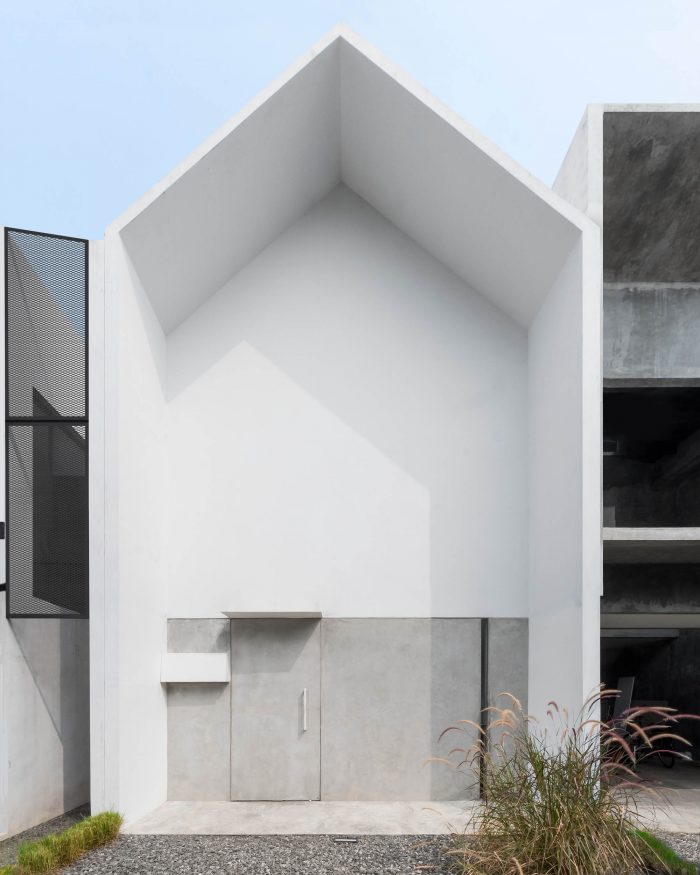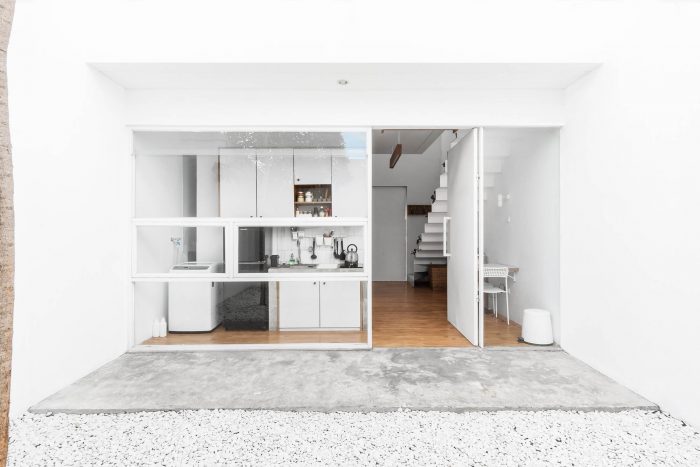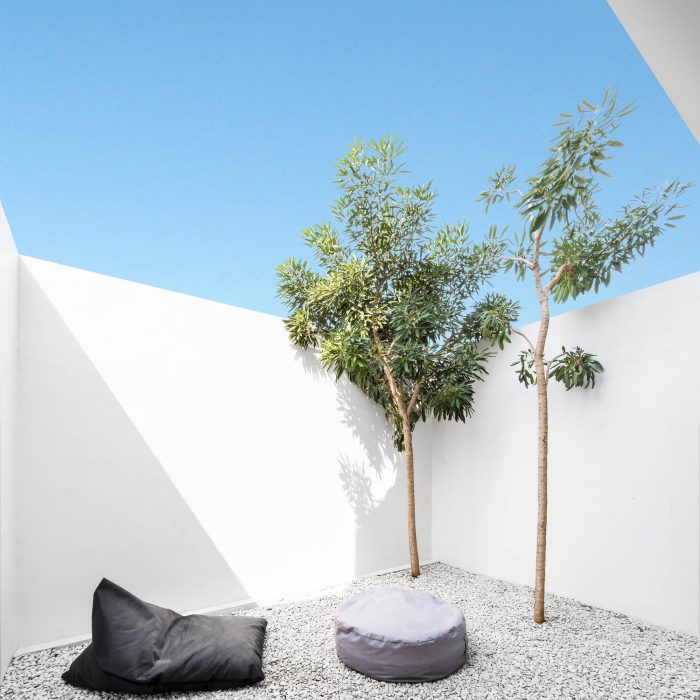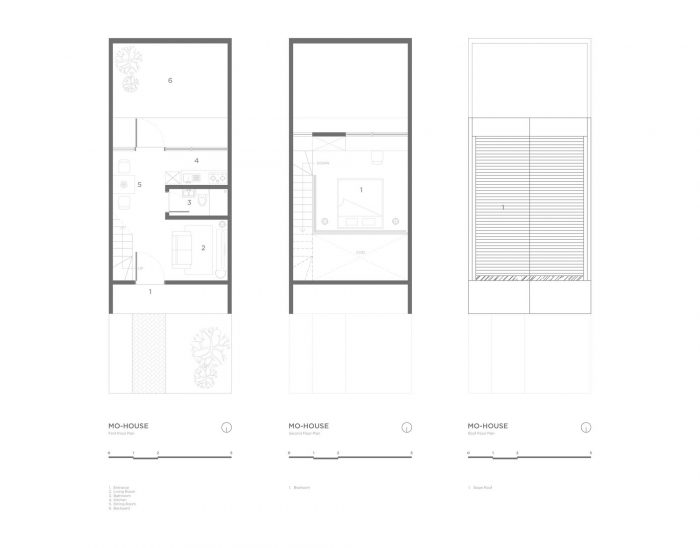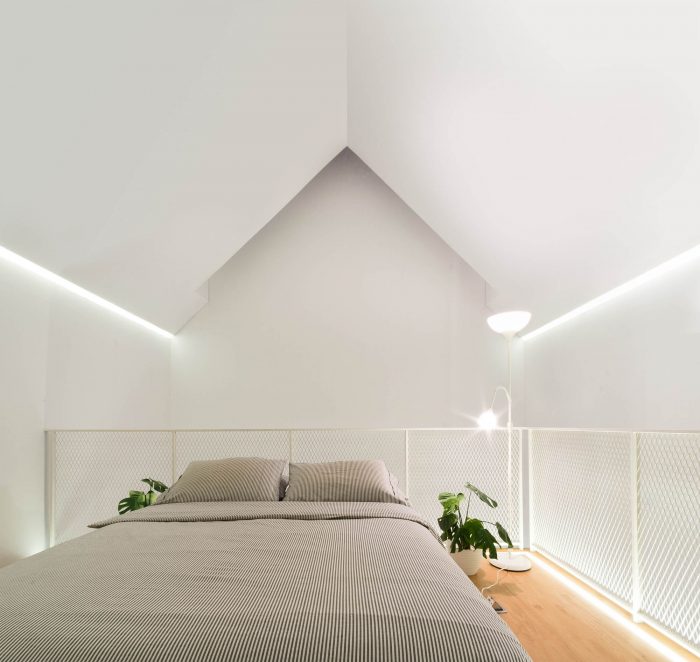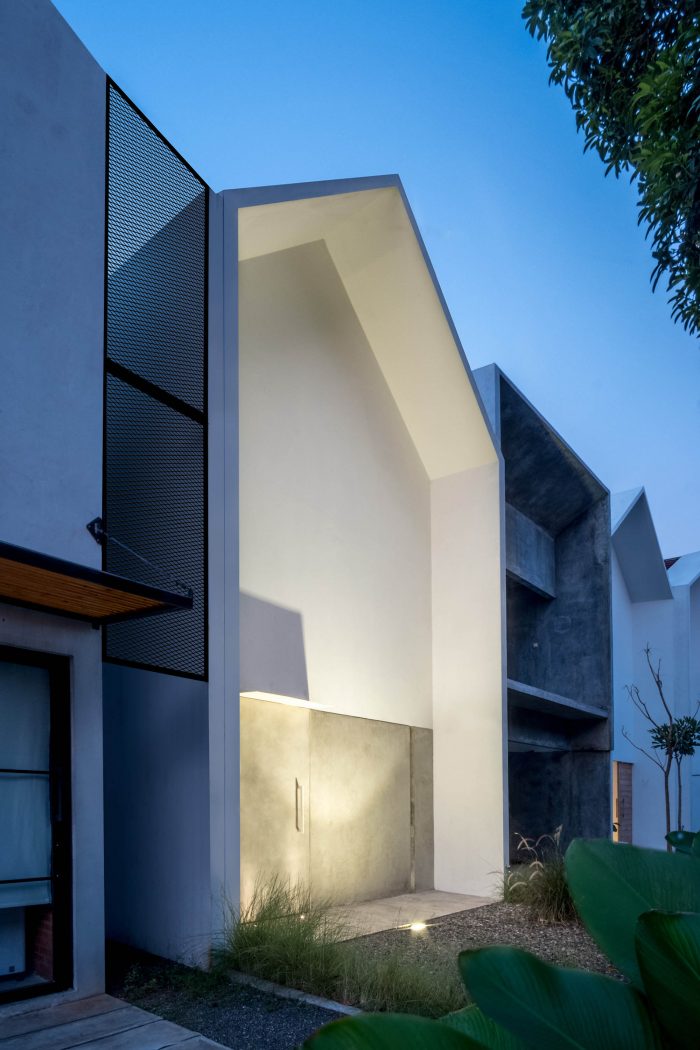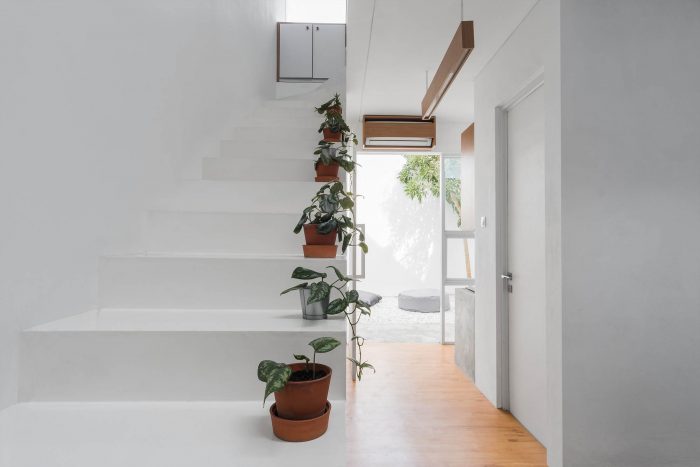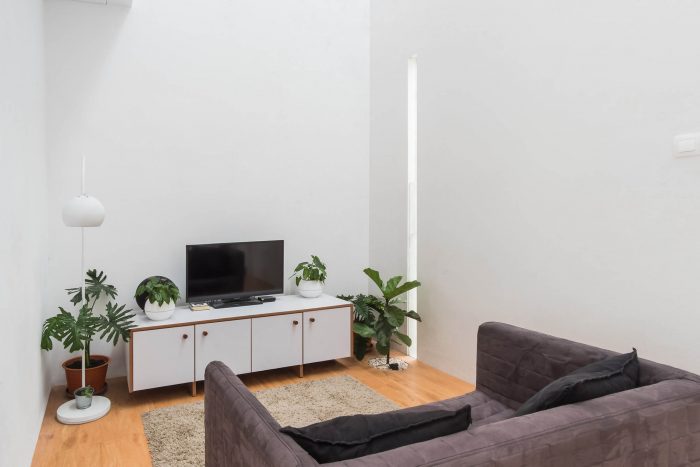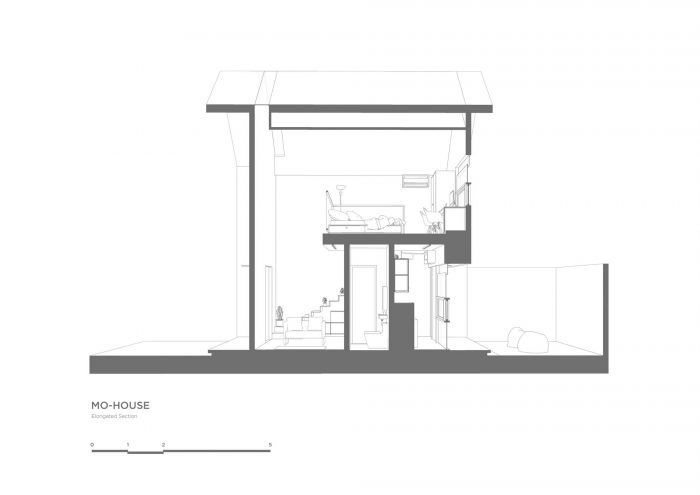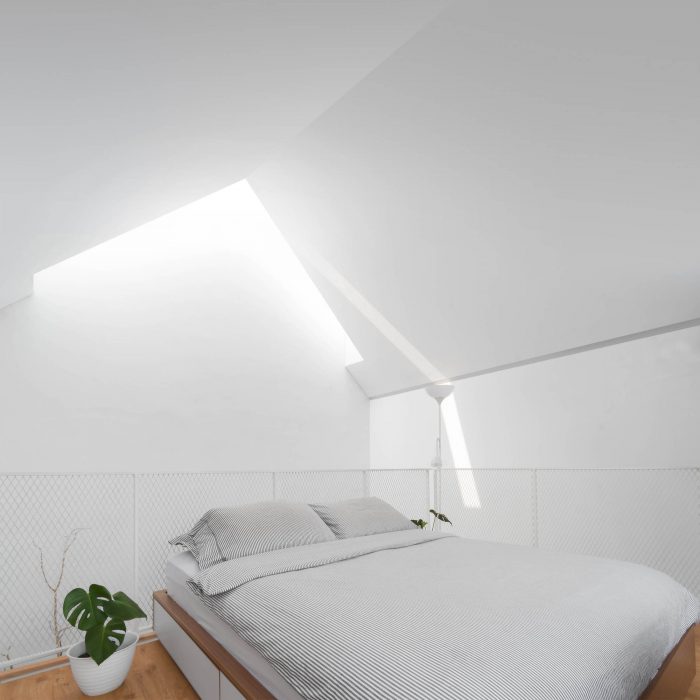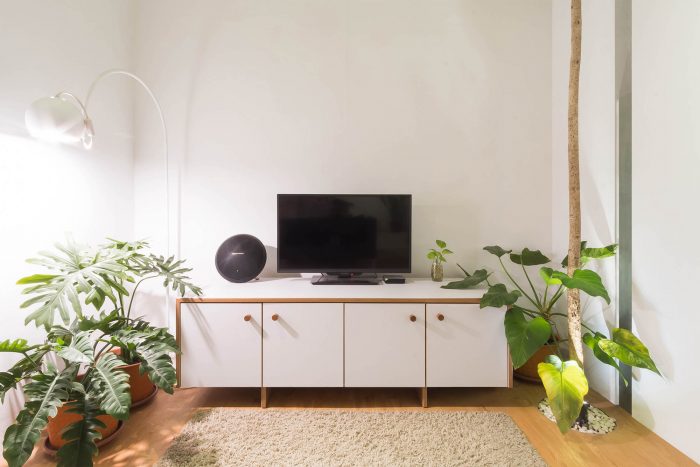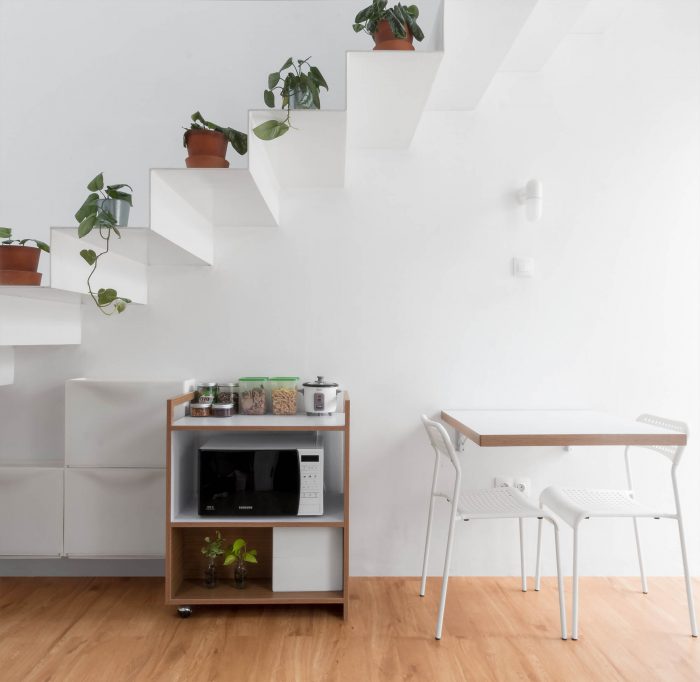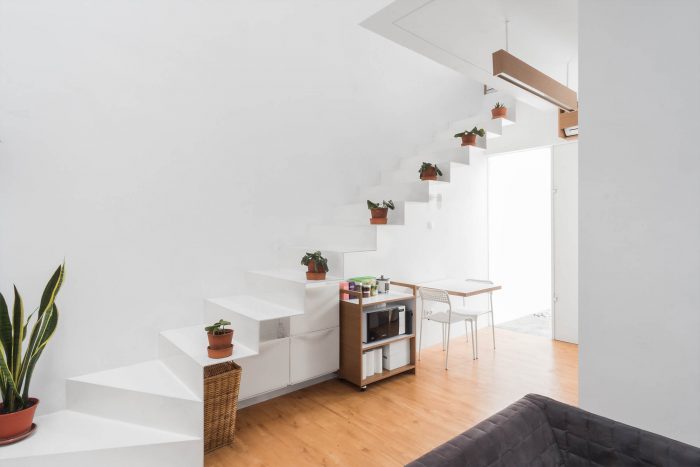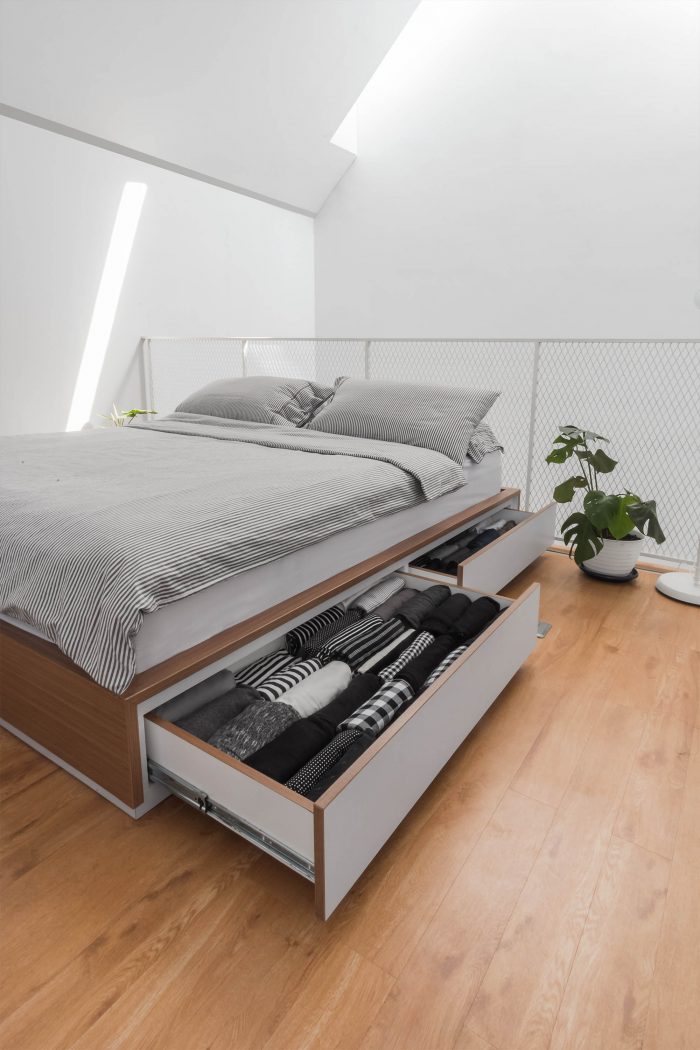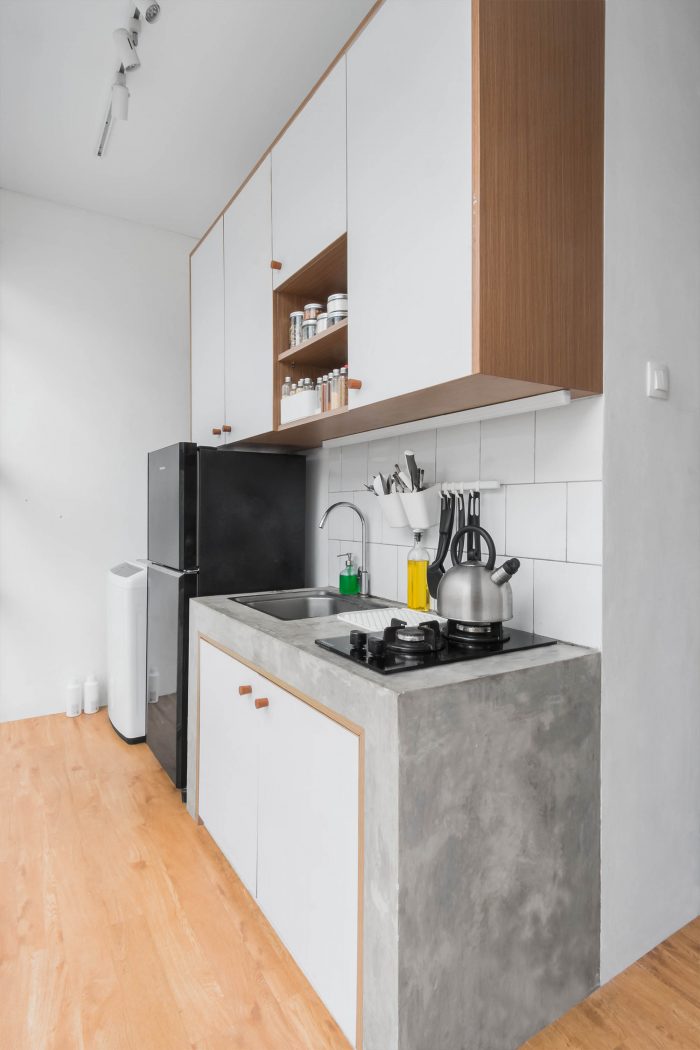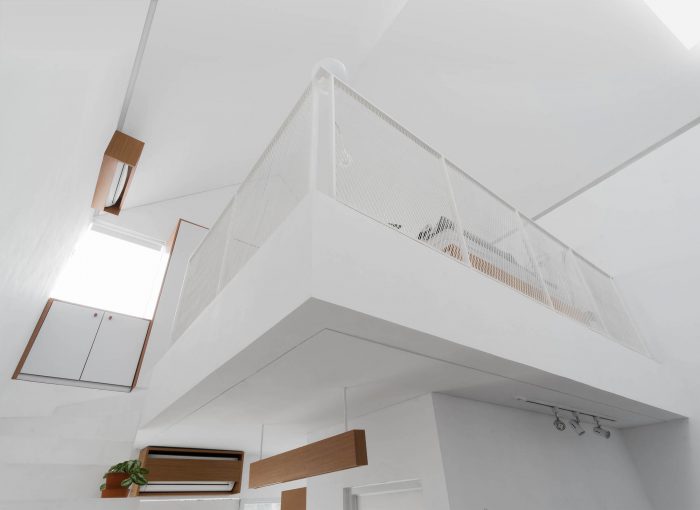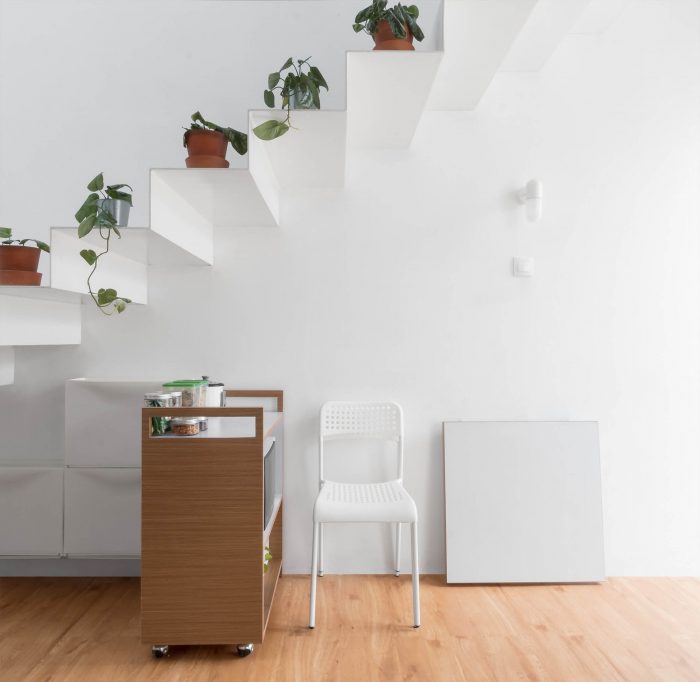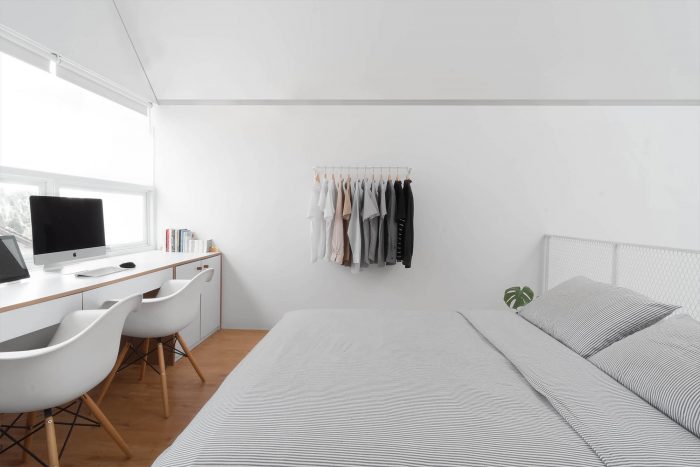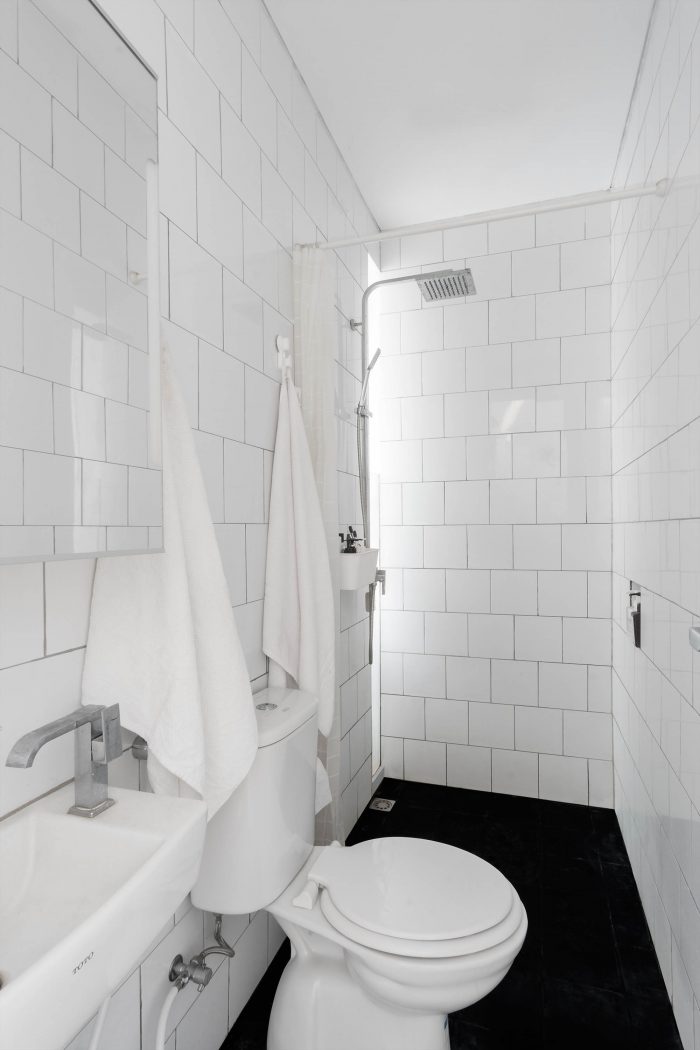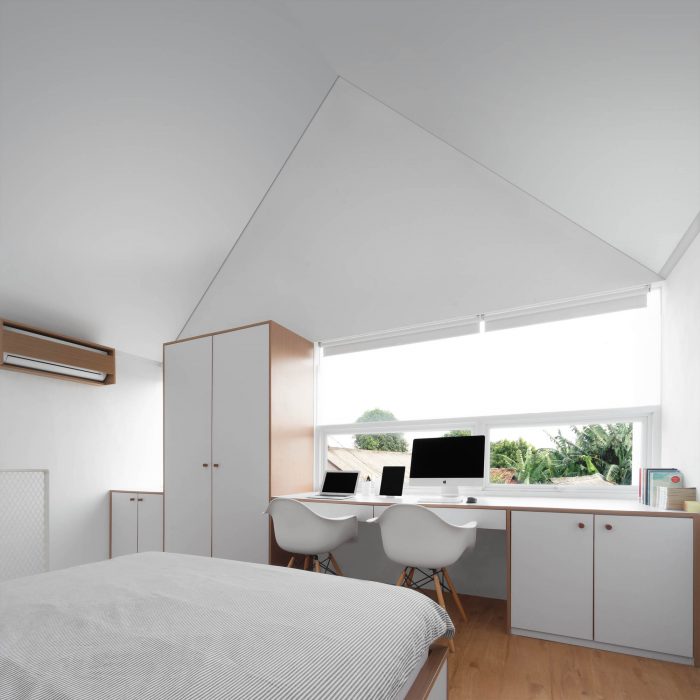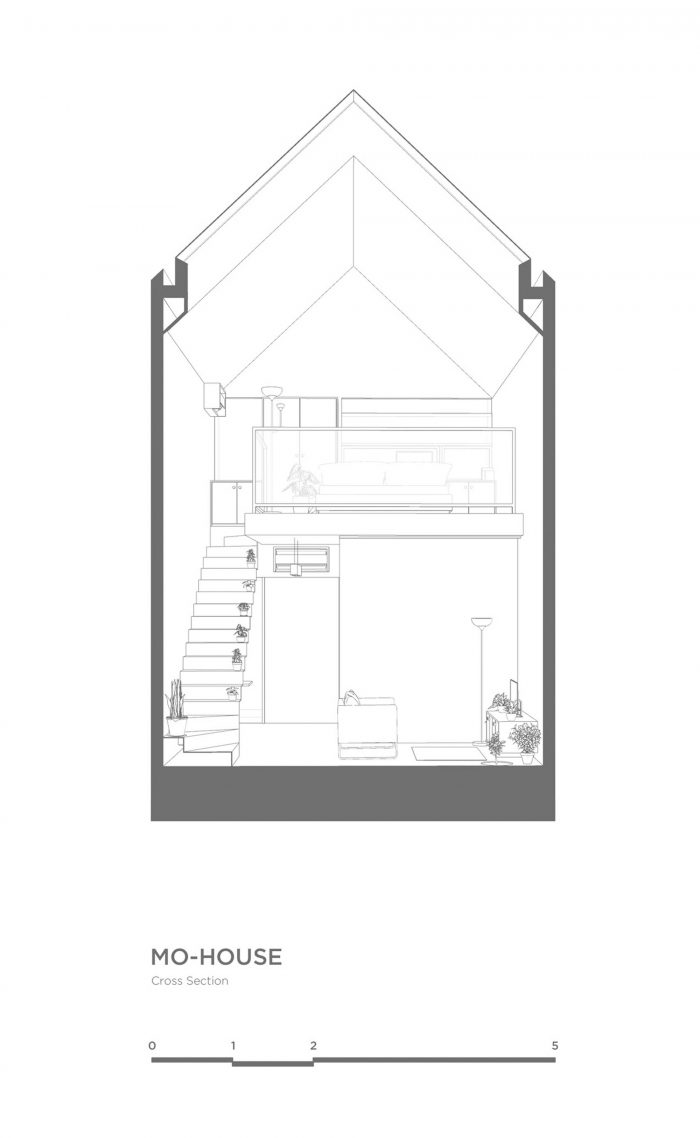改变生活方式
MO House首先关注的是一个挑战:为一对新婚夫妇建造一个负担得起的房子,让他们在有限的区域内建立一个家庭,同时改变生活方式。Mande Austriono–DFORM的建筑师和房子的主人–希望在他的建筑中倡导极简主义的生活方式。因此,MO House试图通过保持其空间的基本质量和程序来体现这种精神。它试图从形式中找到自己的灵魂:材料、细节、照明和人的状态。在延续中,干净的空间可以引导用户只保留必要的东西,消除保留不必要的东西的不满。
ALTERING A LIFESTYLE
MO House first focus on a challenge: to make an affordable house for a newlywed couple that is going to grow a family in a limited area whilst altering a lifestyle. Mande Austriono—an architect of DFORM and the owners of the house—wants to advocate the minimalist lifestyle in his architecture. Therefore, MO House tries to embody that spirit by keeping its space stripped down to its essential quality and programs. It tries to find its soul from the form: material, detail, lighting, and the human condition. In continuation, the clean space can lead the users to only keep what is necessary and eliminate the discontent in keeping unnecessary things.
这个房子的开放性和干净的空间导致了一个程序的消除:一个储藏室。知道极简主义不是一个单纯的建筑风格,这是DFORM想要传递的思想。”我们真的很欣赏我们需要的东西。每当我和我的妻子购买一些物品时,我们都会深入检查和思考:我们真的需要它吗?如果我们需要,需要多长时间?当我们不再需要那件物品时,我们应该感谢它一直在给我们提供我们需要的价值–每件物品都有一个灵魂。然后,我们应该把它捐赠给其他有需要的人。这是我们保持物品清洁的解决方案,当然,储藏室不是一个。虽然它不在视线范围内,但不意味着它不在头脑中。”
The openness and the cleanliness space of this house cause one program elimination: a storage room. Knowing that minimalist is not a mere architectural style, this is the thought that DFORM wants to deliver: “We really appreciate what we need. Every time my wife and I buy some items, we deeply examine and contemplate: do we really need it? If we do, for how long? When we no longer need that item, we should be thankful that it has been giving us the value we needed—whereas each item has a soul. Then after, we shall donate it to others in needs. This is our solution in maintaining our things clean and of course, a storage room isn’t one. Just because it is out of sight, doesn’t mean it’s out of mind.”
增长的能力
MO House是为那些想拥有房子的夫妇的成长型家庭设计的,他们通过了解方案的紧迫性:他们在几年内还不需要孩子的卧室。它可以灵活地配置在一些变化的需求模式。它将成长为两个阶段,并随着他们的方案成长。由于这种增长通常是不平衡的和预防性的,重要的是MO之家能成为一个知道从哪里开始、增长和结束的住所。整个过程需要确定:第一阶段将发生多长时间,以及第二阶段将何时发生。同时,通过了解建筑过程的阶段,业主知道他们需要为第一阶段以及第二阶段精确分配多少储蓄。因此,MO House的预算是不需要一次性要求很多钱的。
THE ABILITY TO GROW
MO House is designed for the growing family of a couple who wants to have a house by understanding the urgency of the programs: they not yet need a children bedroom for a couple of years. It is flexibly configured in some changing patterns of demand. It will grow into two phases and go along their program growth. As this growth usually uneven and precautions, it is important that MO House can be a dwelling that knows where to start, to grow, and to end. The whole process needs to be determined: how long the first phase will going to occur, as well as when the second phase will going to occur. At the same time, by understanding the phase of the building process, the owners know how much they need to precisely allocate their savings for the first phase, as well as the second phase. Therefore, MO House is budget friendly that it does not need to require a lot of money at one time.
MO House第一阶段的主要项目很简单:一个双层高的客厅作为起点,然后在房子的内部有一个卫生间,作为客厅和储藏室之间的分隔物使用。一进门,左边还有一个钢板楼梯,可以进入二楼的阁楼式卧室,供一对夫妇居住。这个阁楼式的卧室有一个白色的拱形天花板,上面有一个天窗,将卧室向上延伸。它提供了一种宽敞的感觉,以折中由于卧室面积小而产生的规模。楼梯下面的开放性是由没有结构的钢板楼梯创造的,这也给下面的空间带来了灵活性,可以转变为不同的方案。因此,家具也是可移动的,可以重新创造一些不同的方案和空间组合。另外,楼梯上没有栏杆的情况被植物盆栽所取代,作为缓冲。
The main programs in the first phase consisted in MO House are simple: a double-height-living room as a starting point, then a bathroom in the inner parts of the house that is utilized as a separator between the living room and pantry. Upon entry, there’s also a steel-plate staircase on the left to access a loft-style bedroom on the second floor for a couple. This loft-style bedroom has a white-vaulted-ceilings with a skylight which extends the bedroom upward. It provides a spacious feeling to compromise the scale due to the small area of the bedroom. The openness below the stairs that created by steel-plate staircase without structure also give birth to the flexibility of space below to transform into different programs. Thus, the furniture is also moveable to recreate some various programs and space combinations. Also, the absence of a railing in the stairs is replaced by plant pots as a buffer.

在房子的后面,有一个茶水间,由大玻璃窗代替墙壁与后院相隔。后院本身成为第二阶段空间增长的潜在空间:二楼是儿童卧室,下面是客厅的延伸。没有砖墙会使拆除过程变得更有效率,因为大玻璃窗很容易被拆开。通过向后院增长空间–横向–而不是纵向,业主在建筑施工时仍可以住在房子里,这也可以减少开支。大型前门和后门的超比例线性循环也是为了方便建筑材料从前院到后院的分配而准备的。
At the back of the house, there is a pantry—separated by large glass windows as a substitution for wall—with the backyard. The backyard itself becomes a potential space for space growth in the second phase: children bedroom on the second floor and below, an extension of the living room. The absence of a brick wall will make the dismantle process become more efficient due to the fact that the large glass window is easily detached. By growing a space towards the backyards—horizontally—instead of vertically, the owners can still live in the house while the building construction occurs which can also reduce the expenses. The large front door and back door in over-scaled linear circulation are also prepared for an ease in the distribution for building materials from the front yard to the backyard.
第二阶段将产生一个与第一阶段相分离的体块,由一座桥连接。分离的体量使两个卧室都有一个大的开口,有玻璃窗,彼此相向。尽管MO之家建在有限的土地上,但小气候的原则可以在整个房子里得到运用。在这个成长的空间里,最重要的是,这个阶段知道哪里是终点。它不会成为一个无形的肿瘤,并且有模糊性:哪种形式将被结束并被享受。
The second phase will produce a detached mass from the first phase that is connected by a bridge. The mass detachment allows both bedrooms to have a large opening with glass windows that face each other. Despite the fact that MO House is built on a limited land, the principles of microclimate can be employed throughout the house. The most important thing in this growing space is that the phase knows where to end. It will not become a tumor that formless and have ambiguity: which form is going to be ended and to be enjoyed.
空间的分离
MO House建在DFHousing的一个社区里,在5 x 14.5米的地块上有10个形状和大小相似的住宅。房屋前1.2米的狭窄步行街成为社区居民相互接触和交流的公共空间。公共和私人空间的分离是需要做的。MO房子的外皮被干净的白墙挡住,作为房子内部和外部生活之间的缓冲和过滤。外墙被认为是业主的特征,他们想把自己从公众中封闭在MO House的安全内部。在那里,有一个具有不同特点的空间的广阔性:开放性。
A SEPARATION OF SPACE
MO House is built in a DFHousing neighborhood where there are ten similar shape and size dwellings within the 5 x 14.5 m lots. The narrow pedestrian street of 1.2 meters in front of houses becomes a public space where the community encounter and interact with each other. The separation of public and private space is needed to be done. The outer skin of MO House is blocked by a clean-white-wall as a buffer and a filter between the life within and without the house. The façade perceived as a character of the owners that want to enclose himself from the public in MO House’s secure interior. There inside, lay an expansiveness of a space with a different character: an openness.
双层高的客厅被漆成白色,这样从天窗倾泻而下的自然光就会反射到上面,给人一种整个房子更宽敞的印象。天窗代替了通常由正面窗户提供的开口的缺失。阁楼式卧室的拱形天花板很适合干净的室内环境:一个宽敞的区域,肯定是一个安静的环境。MO之家所使用的材料类型是简单而谦逊的,它的所有优点和缺点都被完全接受了。为了实现经济型住宅,建筑师必须在材料搭配和装饰方面提供创造性的选择。房子的最终结果是原始的,但尽管如此,房子背后的理念还是得到了很好的体现。
The double-height living room is painted in white color so that the natural light that pours from the skylight is reflected on it and give an impression of a more spacious area throughout the house. The skylight becomes a substitution for an absence of the opening that usually provided by front-facing windows in the façade. The vaulted ceiling in the loft-style bedroom has been well suited with a clean interior: a spacious area and surely a quiet environment. The type of material that has been used in MO House is simple and humble that it has been fully embraced with all its strengths and flaws. To achieve a budget house, the architect has to deliver a creative selection in material pairing and finishing. The final result of the house is raw, but nonetheless, the idea behind the house is well-presented.
Architects: DFORM
Area: 55 m²
Year: 2016
Photographs: Mande Austriono Kanigoro
Manufacturers: Dulux, Toto, Acor, Isjava, Paloma
Lead Architect: Mande Austriono Kanigoro
City: TANGERANG SELATAN
Country: Indonesia


